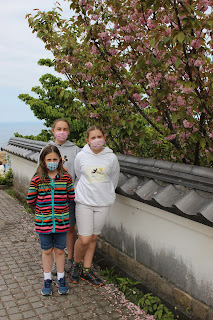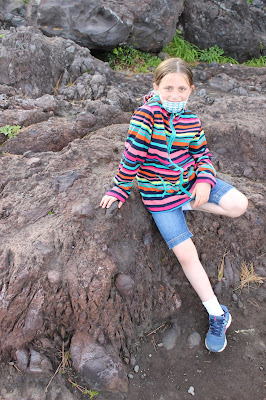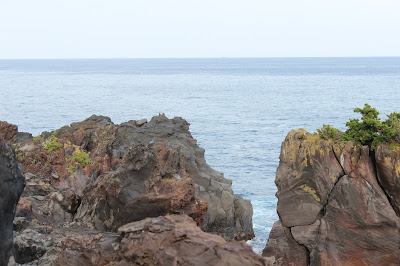When we arrived in Japan, the very first Japanese person I spoke to, when I asked her what her favorite place was, told me that we MUST visit the Izu Peninsula. Finally, last week we were able to go. It was fantastic, and I agree with her!
Before we set out, I took some photos of things that were blooming in our garden.
Miss A's Daiso cactus that she got at a long ago young women's activity is just about to bloom for the first time. It spent the first two plus years flopped over the side of its pot, looking limp and scraggly. But in the last few months it has perked, stood up straight, and gotten fat.My little apple tree has blossoms on the end of every twig.
And, as usual, the hellebore I plant looks just fantastic right before I move. Someday I will live somewhere long enough for perennials to mature, and then be able to enjoy them for a while...
We set off, with the usual amusing road sights.
This guy was super serious about keeping his camping gear safe. The town of Atami, our first stop, is about 80 kilometers, or 50ish miles from our home. In the western US, that would take maybe half an hour. Here, it's two. But this was a pleasant drive, right along the Sagami Bay.
Our first stop was Izusen Shrine. It is famous for having 837 steps, but the girls only counted about 180. We figure there must be a way to start at the ocean and climb up. LUCKILY we have a car.
It was still so many stairs. And then we hiked up the mountain behind the shrine to see what we could see. It was a nice forest, and we saw a cuckoo bird.Shrines and temples are interesting places. People pay for little fortune slips of paper, and then tie them on displays, in hopes that the bad luck will stay there to be purified. I think they are pretty and colorful.
Two spitting dragons on the hand washing/ purification fountain.
Here is the view from the top of the mountain.
The shrine through the momiji, or Japanese maples.
This shrine has a carving I haven't seen before on a shrine, a carp. Koi are a symbol of perseverance in the face of adversity, and I thought this was very beautiful.
There was also a pond with the real thing. The girls happily fed them from the fish food vending machine, and then a nice lady gave them some more food.
I am a rabid goshuin collector, so I was very happy to get a stamp at Izusan-jinja. If you haven't heard of goshuin before, they are stamps with calligraphy placed in a special book. At many shrines and temples, you can pay 300 yen (500 if it's a big famous place), and the monk or shrine maiden will write and stamp in your book. Since covid, most places have pre-written papers that you take and tape in your book. I think they are super fun, and I'm filling up my fourth book.
Our next stop was also a shrine. I was excited for this one, because it is famous for having a 2000 year old camphor tree. Do you know the difference between shrines and temples in Japan? Shrines belong to the native Japanese Shinto religion. They will usually have the unique torii (pronounced tor-ee-ee) gates like Miss R is standing in below, and guardian lion dogs, called komainu. Temples are Buddhist. But in reality, sacred places often are kind of mixed up between the two religions, due to the thousands of years of changing politics and amounts of influence by China in Japan.
This is not the 2000 year old tree, although, seriously, it is an amazing tree. Nobody does old like Japan, I always say...
A friendly komainu.
This is The Tree. Isn't it gorgeous? Miss R asked if Jesus ever visited this tree. I told her that although I personally believe He visited this country after His resurrection, we don't know for sure. And this tree would have been a normal everyday sort of tree back then. Although just thinking that we touched something alive when Jesus walked the earth is kind of staggering.Here is the goshuin from this shrine, Kinomiya-jinja.
Our next stop was the Akao Herb and Rose Garden. I was pretty floored by this place. I mean, I have fairly high garden standards... This place was pretty cool. And we were at just the perfect time of year. We missed the sakura blossoms, except the late kwanzans, but the tulips were at their height. It was perfect! And, the tickets included a bus ride to the top of the mountain, so we only had to wander down. And they wouldn't let us pay for Miss R for some reason.
The garden has a little shrine right at the top. No goshuin, but they sold a little ema, which is another thing I collect. They are little plaques people write prayers on, to tie up at the shrine or temple so the kami, the spirit or divinity, can read them. We sign the back with the date and place, keep them, and use them for Christmas tree ornaments.
There were lots of places to pose for photos at this garden. Luckily it was not very crowded. These hammocks were a big hit with the girls, as well as the swing.
Now be prepared for billions of flower photos. Your typical Japanese garden isn't famous for flowers, per se. Maybe some peonies or chrysanthemums in very prominent positions. But my kind of stuffed, crazy flower bed isn't something you generally see here. So I was super happy at this garden!
This is a Banks rose! One of the very early varieties. It's a sprawly climber, and it was everywhere. So pretty.
Poppies.
This garden was so gorgeous, it was begging for wedding portraits. But the only professional type photographer I noticed this day was doing something rather... different. It was an older man with a huge wagon of photo props, trailing around the garden taking portraits of... a poodle. I'm talking lace parasols, an assortment of hats, the whole deal, all for this little white and dyed fur poodle. It was so funny. I made the girls pose for me.
Just a garden on a hill, with a castle in the distance.
Masks have not been a cause of contention here in Japan. We wear them when we're close-ish to people, and pull them down when we're not. Yes, it's warm with them on, but we think it's the polite thing to do, and honestly, we often forget we have them on. For a while our base made us wear them alone outside, and that made me mad, because it's so pointless. But to keep the peace and be polite, we wear them near people.
The garden had a forest games section that was really fun. They had a plinko type game with marbles, a golf putting thing, chess, a labyrinth swinging platform thing, bowling, and this- put the English letters in alphabetical order.
Whoever did it before us didn't quite get it, but hey, English is tough.
Our last stop for the day was at Jogasaki ocean cliffs and suspension bridge.
It was incredible. The color of the water was unbelievable. And we were getting some nice huge waves.
The Izu peninsula is fascinating from a geologic standpoint. Lots of volcanic activity! We are studying geology in home school right now, so it was fun to talk about it all.
B found this rock. We aren't super experienced geologists, but we figure this looks to us like a lava bomb flew through the air and landed splat in some cooling lava. Isn't that cool! You can see the splash marks.
The girls are such good observers. One of them, can't remember which, spotted this gorgeous blue headed bird. He flew off before I could switch to my long lens. Very pretty!
Big enough to make the deep thrumming sound you feel in your chest.
Back from the waves just a bit honestly felt like a garden. It was lush and green, with species that were valued garden plants when I started working with plants.

This euphorbia was everywhere.

And an actual corydalis. This thing was like gold when I was first working at the nursery.
We went back across the bridge, and I did some more gazing at the clear cold turquoise water.
Then we headed to our hotel, which was very close. We stayed at We Home Villa Jyougasaki, which was deep in a tangled residential area. Very quiet. Too quiet for some people in my family to sleep well. Quiet, that is, until about four am the next morning, when the uguisu, Japanese bush warblers, started their deafening morning chorus. I thought it was a lovely way to wake up. Others, Miss A, were not so appreciative... Our travel eating strategy is usually to check in to a hotel, or large house/hotel like this one, go find the nearest grocery store, and pick from the extensive pre-made food selection for supper, then get yogurt, fruit, and pastries for the next morning's breakfast. Our hotel had an industrial kitchen free for us to use to heat everything up. Thank Heaven B reads Japanese. Japanese microwaves are super complex, and are really a microwave, and oven, a toaster, an air fryer, and will practically solve world problems. But... you have to know which buttons to push. B found the magic "heat up konbini (convenience store) food to the exact perfect temperature" button, so we could all enjoy our noodles, rice, fried chicken, tempura, etc. And of course the three fish eaters in the family had their onigiri and sushi.
It was a great day!































































No comments:
Post a Comment